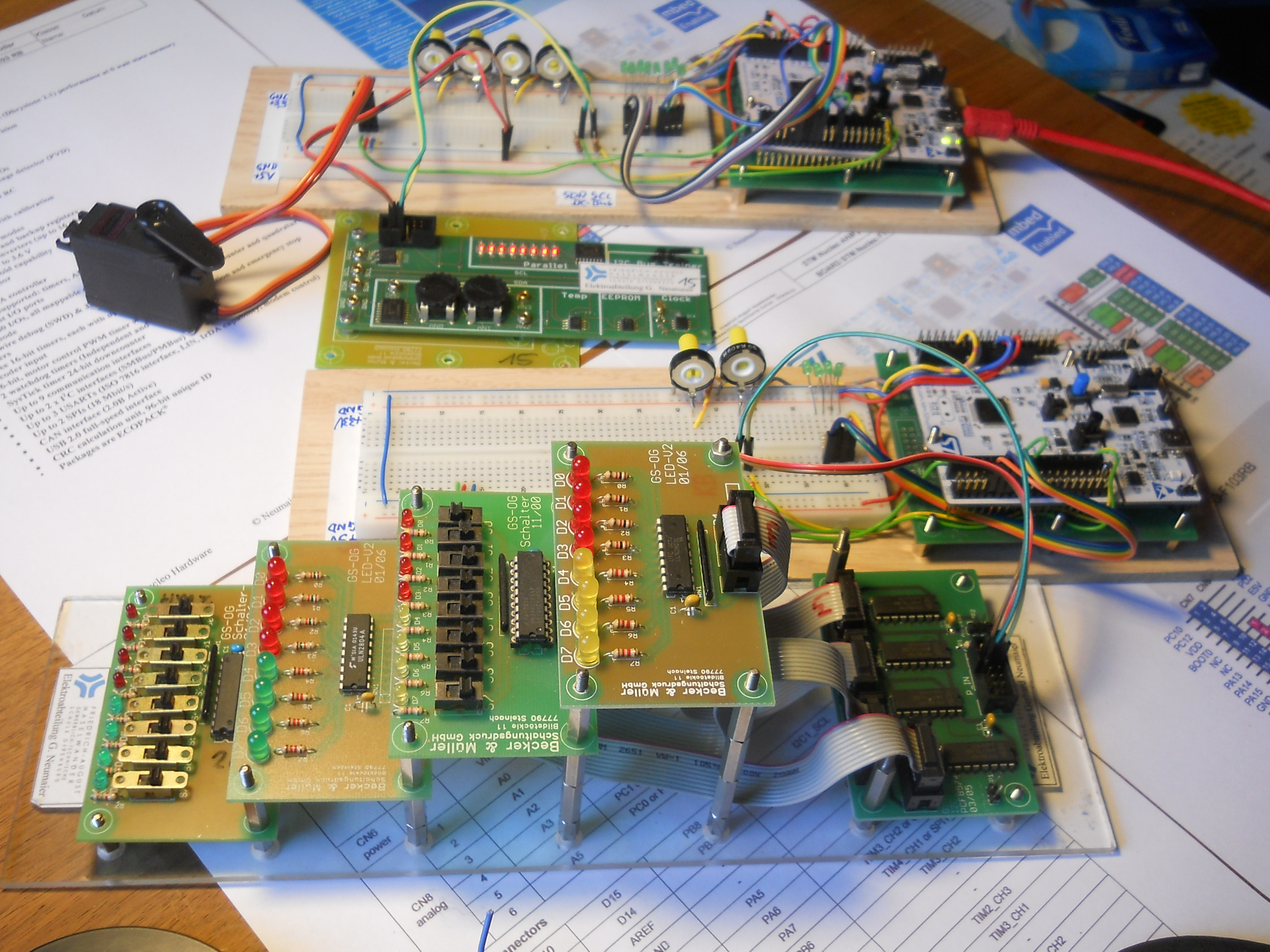Data send-receive by IIC-bus Hardware: IIC-board with 4 x PCF8574 IC you see a 8bit leds this leds show the value from an other 8574 who has 8 switches as input The 8xswitches from IIC you can see also at the pins PC_0 to PC_7
Dependencies: mbed
Fork of Nucleo_IIC_2x8574in_out by
Gerhard Neumaier will show you :

You can see my hardware: Nucleo F103RB with a IIC-bus application
In the background a printed board "IIC-Trainer" with different IIC ICs like PCF8574a, PCF8591, EEPROM; Real-time-clock In the foreground you see right a own-made printed circuit-board with 4x IC PCF8574

Eine Seite auf os_mbed ARM von Gerhard Neumaier Offenburg Feb 2018
Diff: main.cpp
- Revision:
- 0:b183e63b31f8
- Child:
- 1:cb8a26c1d6e9
diff -r 000000000000 -r b183e63b31f8 main.cpp
--- /dev/null Thu Jan 01 00:00:00 1970 +0000
+++ b/main.cpp Fri Aug 21 11:40:23 2015 +0000
@@ -0,0 +1,59 @@
+/*Data send-receive by IIC-bus Hardware: IIC-board with 4 x PCF8574 IC
+you see a 8bit leds this leds show the value from an other 8574 who has 8 switches as input
+The 8xswitches from IIC you can see also at the pins PC_0 to PC_7
+Tasks: 1. Receive a analog value and show this value as a 8xled-strip at the third PCF8574 IC
+ 2. Send the 8xswitches from IIC-bus to the virtuell COM-port. You can visualize the switches
+ with the Software "Profilab" or "LABview"
+Aug. 2015 G. Neumaier Gewerblich-Technische Schule Offenburg Germany
+*/
+
+#include "mbed.h"
+#define PCF8574_ADDRoutput 0x46 // PCF8574 address 0x46 lowest bit (R/W)=0 IICboard P3
+#define PCF8574_ADDRinput 0x45 // PCF8574 address 0x44 lowest bit (R/W)=0 IICboard P2
+ //ADR-Jumper on IIC4xPCF8574board jumped to 0: Basis ADR:P0=0x40;P1=0x42;P2=0x44;P3=0x46;
+ //ADR-Jumper on IIC4xPCF8574board jumped to 1: Basis ADR:P0=0x48;P1=0x4A;P2=0x4C;P3=0x4E;
+#define LED_MASK 0xffff //Portc has 16bit, therefore 4digit mask
+ // 1=output 0=input
+
+I2C i2c(I2C_SDA, I2C_SCL); //IIC Pins SDA and SCL for ARDUINO pinheader Nucleo-board
+ //SCL and SPA pullup resistors 2k2Ohm to+5Volt
+
+PortOut leds(PortC, LED_MASK); //Important: Port_B not possible -> PB_8 PB_9 Pins for IIC-bus
+
+DigitalOut myled(LED1); //LED on Nucleo-board
+//for the task1****: AnalogIn analog_value0(A0); //same as Pin PA_0
+//for the task2****: Serial pc(SERIAL_TX, SERIAL_RX);
+
+int main()
+{
+ char input8bit;
+ char data_write[2]; //must be char!!
+ char data_read[2]; //read buffer
+
+ data_write[0] = 0xf2; //LEDs low aktiv dummy
+ int status = i2c.write(PCF8574_ADDRoutput , data_write, 1, 0);
+ if (status != 0) // Error no acknowledge detected
+ {
+ while (1) //-> endless loop when error no IIC-IC detected
+ {
+ myled = !myled;
+ wait(0.7);
+ }
+ }
+
+ while (1) //endless loop
+ {
+
+ // i2c.read will start the IIC-bus with the last 0 also stop the same by 12c.read
+ i2c.read(PCF8574_ADDRinput, data_read, 1, 0); // read to array 1byte stop
+ input8bit = data_read[0]; //array value to variable
+ leds = input8bit; //Output PortC low-byte
+ data_write[0] = input8bit; //8bit analog-value to array
+ i2c.write(PCF8574_ADDRoutput , data_write, 1, 0); // output array 1byte stop
+ //you see a digital 8bit PCF8574 output (8xleds), received from PCF8574 input (8xswitsches)
+
+ //Here your solutions from task1 and 2:
+ }
+
+}
+


